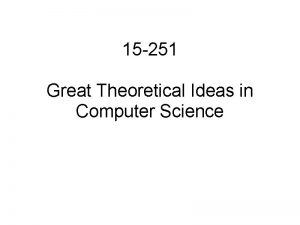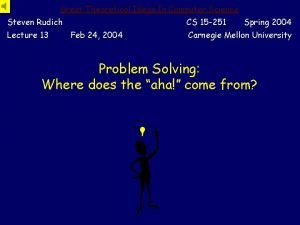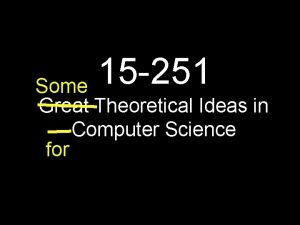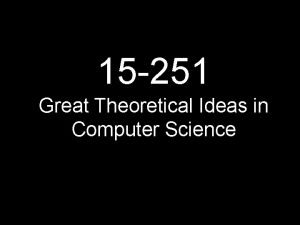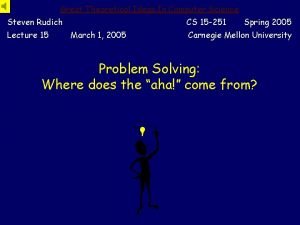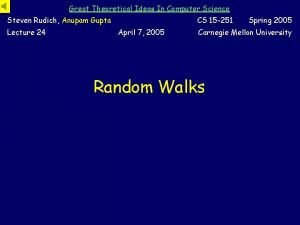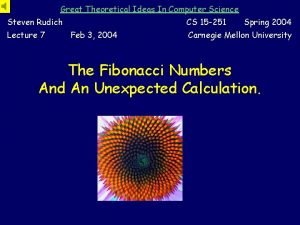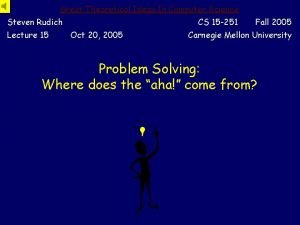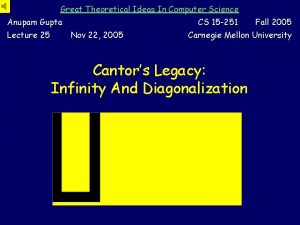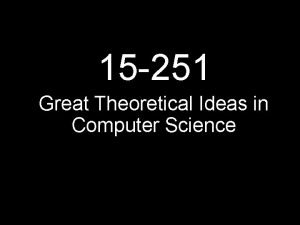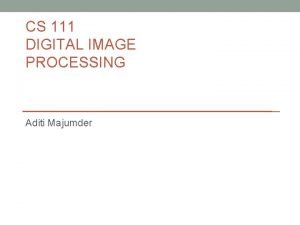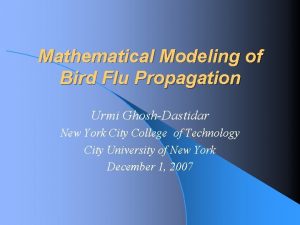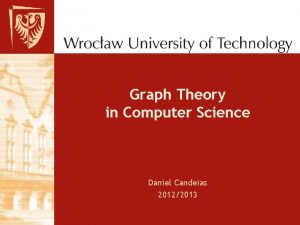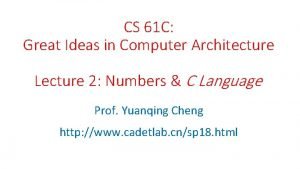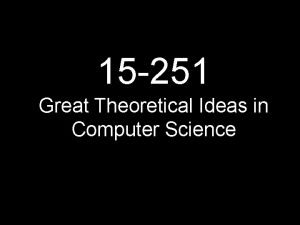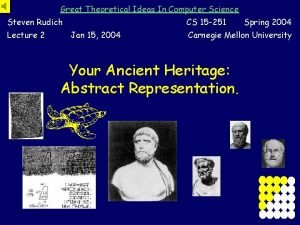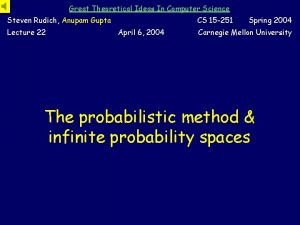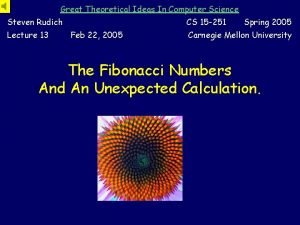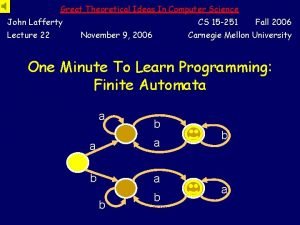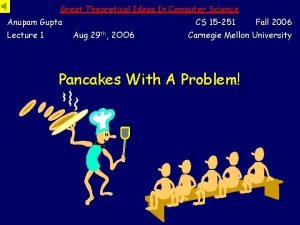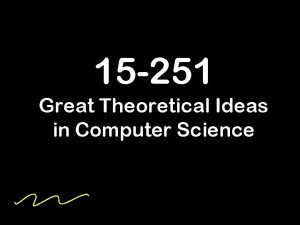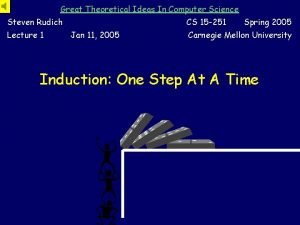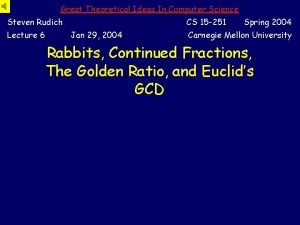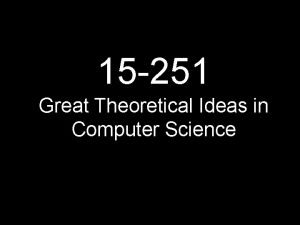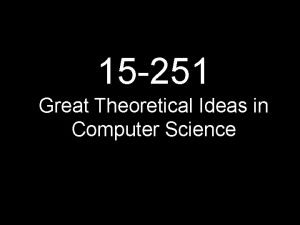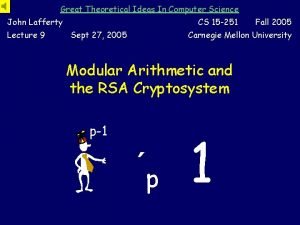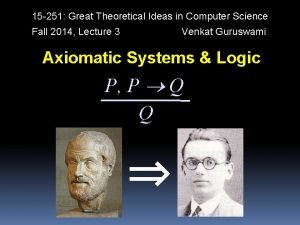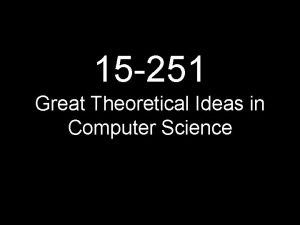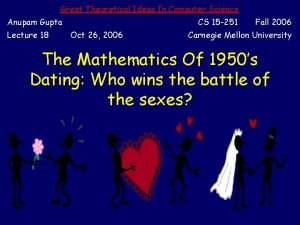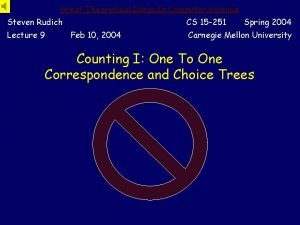Great Theoretical Ideas In Computer Science Urmi Majumder






![The Riemann Hypothesis [1859] Riemann The Riemann Hypothesis [1859] Riemann](https://slidetodoc.com/presentation_image_h2/0b4983f7c722993804f3a076c738b400/image-7.jpg)

















- Slides: 24

Great Theoretical Ideas In Computer Science Urmi Majumder Lecture 16 COMPSCI 102 October 24, 2007 Fall 2007 Carnegie Mellon University Randomness and Computation: Some Prime Examples

Earth has huge file X that she transferred to Moon gets Y. Did you get that file ok? Was the transmission accurate? Uh, yeah. Earth: X Moon: Y

Legendre Let (n) be the number of primes between 1 and n. I wonder how fast (n) grows? Conjecture [1790 s]: Gauss

Their estimates x pi(x) Gauss' Li Legendre x/(log x - 1) 1000 168 172 169 10000 1229 1246 1231 1218 100000 9592 9630 9588 9512 1000000 78498 78628 78534 78030 10000000 664579 664918 665138 661459 10000 5761455 5762209 5769341 5740304 100000 50847534 50849235 50917519 50701542 100000 455052511 455055614 455743004 454011971

De la Vallée Poussin J-S Hadamard Two independent proofs of the Prime Density Theorem [1896]:

The Prime Density Theorem This theorem remains one of the celebrated achievements of number theory. In fact, an even sharper conjecture remains one of the great open problems of mathematics!
![The Riemann Hypothesis 1859 Riemann The Riemann Hypothesis [1859] Riemann](https://slidetodoc.com/presentation_image_h2/0b4983f7c722993804f3a076c738b400/image-7.jpg)
The Riemann Hypothesis [1859] Riemann

Slightly easier to show (n)/n ≥ 1/(2 logn).

Random logn bit number is a random number from 1. . n (n) / n ≥ 1/2 logn means that a random logn-bit number has at least a 1/2 logn chance of being prime.

Random k bit number is a random number from 1. . 2 k (2 k) / 2 k ≥ 1/2 k means that a random k-bit number has at least a 1/2 k chance of being prime.

Really useful fact A random k-bit number has at least a 1/2 k chance of being prime. So if we pick 2 k random k-bit numbers the expected number of primes on the list is at least 1

Picking A Random Prime Many modern cryptosystems (e. g. , RSA) include the instructions: “Pick a random n-bit prime. ” How can this be done efficiently?

Picking A Random Prime “Pick a random n-bit prime. ” Strategy: 1) Generate random n-bit numbers 2) Test each one for primality [more on this later in the lecture]

Picking A Random Prime “Pick a random n-bit prime. ” 1)Generate kn random n-bit numbers 1. Each trial has a ≥ 1/2 n chance of being prime. 2. 3. Pr[ all kn trials yield composites ] ≤ (1 -1/2 n)kn = (1 -1/2 n)2 n * k/2 ≤ 1/ek/2

Picking A Random Prime “Pick a random n-bit prime. ” Strategy: 1) Generate random n-bit numbers 2) Test each one for primality For 1000 -bit primes, if we try out 10000 random 1000 -bit numbers, chance of failing ≤ e-5

Moral of the story Picking a random prime is “almost as easy as” picking a random number. (Provided we can check for primality. More on this later. )

Earth has huge file X that she transferred to Moon gets Y. Did you get that file ok? Was the transmission accurate? Uh, yeah. Earth: X Moon: Y

Are X and Y the same n-bit numbers? p = random 2 logn-bit prime Send (p, X mod p) Answer to “X Y mod p ? ” Earth: X Moon: Y

Why is this any good? Easy case: If X = Y, then X Y (mod p)

Why is this any good? Harder case: What if X ≠ Y? We mess up if p | (X-Y). Define Z = (X-Y). To mess up, p must divide Z. Z is an n-bit number. Z is at most 2 n. But each prime ≥ 2. Hence Z has at most n prime divisors.

Almost there… Z has at most n prime divisors. How many 2 logn-bit primes? A random k-bit number has at least a 1/2 k chance of being prime. at least 22 logn/(2*2 logn) = n 2/(4 logn) >> 2 n primes. Only (at most) half of them divide Z.

Theorem: Let X and Y be distinct n-bit numbers. Let p be a random 2 logn-bit prime. Then Prob [X = Y mod p] < 1/2 Earth-Moon protocol makes mistake with probability at most 1/2!

Are X and Y the same n-bit numbers? Pick k random 2 logn-bit primes: P 1, P 2, . . , Pk Send (X mod Pi) for 1 ≤ i ≤ k k answers to “X = Y mod Pi ? ” EARTH: X MOON: Y

Exponentially smaller error probability If X=Y, always accept. If X Y, Prob [X = Y mod Pi for all i] ≤ (1/2)k
 Great theoretical ideas in computer science
Great theoretical ideas in computer science Great ideas in theoretical computer science
Great ideas in theoretical computer science Great theoretical ideas in computer science
Great theoretical ideas in computer science 15 251
15 251 Great theoretical ideas in computer science
Great theoretical ideas in computer science Great theoretical ideas in computer science
Great theoretical ideas in computer science Great theoretical ideas in computer science
Great theoretical ideas in computer science Vocabularize
Vocabularize Great theoretical ideas in computer science
Great theoretical ideas in computer science Great theoretical ideas in computer science
Great theoretical ideas in computer science Tan hee juan case
Tan hee juan case Aditi majumder
Aditi majumder Great ideas in computer science
Great ideas in computer science Wlp
Wlp Urmi ghosh-dastidar
Urmi ghosh-dastidar Urmi vaidya-mathur
Urmi vaidya-mathur In computer
In computer Eight great ideas in computer architecture
Eight great ideas in computer architecture Cs 61
Cs 61 Cs61c
Cs61c 8 great ideas in computer architecture
8 great ideas in computer architecture Math is my favorite subject
Math is my favorite subject Ideas have consequences bad ideas have victims
Ideas have consequences bad ideas have victims Que es una idea principal
Que es una idea principal China big idea
China big idea
